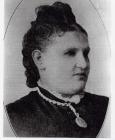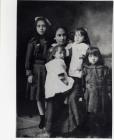2
The traditional role of a Jewish woman was centred around the home, as wife, as mother, and as a follower of the dictates of the Jewish laws which had been recorded in the Torah (Five Books of Moses). In some communities, particularly in the shtetls of Eastern Europe, where many men focused their energies on religious studies, women may also have taken on the role of breadwinner for the family, by selling goods in the marketplace or working for others. Women were also generally separated from men in the religious life of the synagogue through separate seating and a lack of a role to play within the public religious life of their community.This traditional role began to change at the end of the nineteeth century as women began to look beyond their doorsteps to the social needs of the community in which they lived. This was also the case in Saint John, New Brunswick, as the small community of Jewish women made the transition from their homes to the community to the professions and public lives
The first Jewish family to settle permanently in Saint John was the Hart family, led by Solomon and Alice (née Davis) Hart and their children. The Harts came from London, England, where Solomon Hart had learned the cigarmaking trade. They were followed by the Greens Nathan and Jane and their children, also cigarmakers. Other families followed and these original families intermarried to form the nucleus of the Saint John Jewish community.
Alice Hart was a pioneer in her own right. The Dictionary of Canadian Biography described her as "noted for her nobility of mind and soul and love for all that was right." She was born in London, England in 1834 to an affluent family which allowed her to attend a Jewish boarding school and to become a Hebrew scholar. This did not make her an unusual women in England, but it did set a standard in her adopted community in Saint John, where she assumed a strong leadership role among the Jewish women of the community. Her efforts began with the provision of a Hebrew education of the community's children, seven of which were hers, in her home prior to the establishment of a formal congregation. She would move on to found the first Jewish ladies' organization - the Daughters of Israel.
4
A second wave of immigration began in the 1890's with the arrival of Jews fleeing persecution in Eastern Europe. The males in these families arrived first and made their livings primarily as peddlars. Having saved some money they would then send back to Europe for their wives, children and other family members. Others would return to Europe, take a bride from the "old country" and then return to Saint John. Eastern European immigration had ended by 1930 due to restrictions imposed by the Canadian government on types and numbers of immigrants allowed in to Canada. Jews were among the restricted groups. The women in this group relied initially on the support of the women who preceded them to help them establish themselves in their new environment, before branching out on their own or even replacing these women in leadership roles.The women in these early days were hard workers - truly helpmates to their husbands who were becoming merchants, serving customers, raising large families, maintaining a proper Jewish home and looking to serve the community at large both within and without the Jewish ghetto in the city's North End. Their service included all of the Jewish community, but over time extended in the general Saint John community and was focused on the social welfare of the communities they served.
5
It was rare in the early days of the community to see young women sent on to higher education, but this was changing by the 1950s and many contemporary women have embarked on professional careers in cities throughout Canada and the United States. Early educational efforts directed women towards traditional careers in nursing or teaching, but those who followed have followed more diverse paths.This is their story.

